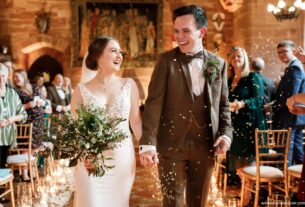Creating the perfect wedding playlist is both an art and a science, combining musical taste with an understanding of the event’s flow and guest preferences. The right playlist sets the mood, keeps energy levels high, and ensures that everyone has a great time from the ceremony to the last dance. Here’s a detailed guide to help you craft a wedding playlist that hits all the right notes.
1. Understand the Wedding Flow
A wedding typically has several distinct segments, each requiring a different musical atmosphere:
- Pre-Ceremony: As guests arrive and find their seats, play soft, welcoming music. Think classical pieces, acoustic covers, or gentle jazz to set a relaxed tone.
- Ceremony: This is the heart of the wedding, so choose songs that hold personal significance. Traditional weddings might include classic processional pieces like Pachelbel’s “Canon in D,” while modern ceremonies might opt for meaningful contemporary songs.
- Cocktail Hour: This is a time for mingling, so keep the music upbeat but not overpowering. Light jazz, bossa nova, or instrumental versions of popular songs work well.
- Dinner: During dinner, the music should be subdued but still engaging. Soft rock, soul, or jazz standards can create a pleasant dining atmosphere.
- Reception and Dancing: This is where the energy ramps up. Mix genres and tempos to keep the dance floor lively, including classics, current hits, and songs that cater to different age groups.
- Last Dance: End the night with a song that feels like a grand finale, whether it’s a romantic ballad or an upbeat anthem.
2. Incorporate Personal Preferences
Your wedding playlist should reflect your personality and tastes as a couple. Start by listing your favorite songs and artists. Think about songs that have special meaning to your relationship, such as the song playing during your first date or a favorite concert you attended together. Include these in key moments like the first dance or during the cake cutting.
3. Consider Your Guests
While your preferences are important, remember that your guests also contribute to the atmosphere. Aim to include a variety of genres and eras to appeal to all age groups. For instance, mix Motown hits for the older crowd with current pop songs for younger guests. Also, consider cultural or regional music if it’s relevant to your family and friends.
4. Create a Balance
A good playlist has a natural ebb and flow. Mix up the tempos to keep things dynamic. Too many slow songs can make the reception feel sluggish, while too many fast tracks might exhaust your guests. Plan a mix of high-energy dance songs with slower, romantic tunes to give everyone a chance to catch their breath.
5. Plan for Key Moments
Certain moments in a wedding require specific songs:
- First Dance: Choose a song that is meaningful to you both. It doesn’t have to be a traditional love song; it could be any track that resonates with your story.
- Father-Daughter and Mother-Son Dances: Pick songs that capture the relationship and emotions of these special dances. Classics like “My Girl” by The Temptations or “What a Wonderful World” by Louis Armstrong are popular choices.
- Cake Cutting: Select a fun, playful song that adds to the celebratory mood, like “Sugar” by Maroon 5 or “How Sweet It Is” by James Taylor.
- Bouquet and Garter Toss: Upbeat and lively songs work best here, such as “Single Ladies” by Beyoncé for the bouquet toss and “SexyBack” by Justin Timberlake for the garter toss.
6. Get Professional Help
Hiring a professional DJ or band can make a significant difference. They bring expertise in reading the crowd and keeping the energy high. Provide them with your must-play list, do-not-play list, and key songs for special moments, but also trust their judgment to adapt to the vibe of the room.
7. Use Technology Wisely
If you’re creating a playlist on a streaming service like Spotify or Apple Music, consider these tips:
- Collaborative Playlists: Use these to gather song suggestions from your bridal party or close friends.
- Pre-Made Playlists: Explore wedding-themed playlists for inspiration or to fill gaps in your own.
- Offline Mode: Ensure your playlist is available offline to avoid any streaming issues due to poor internet connectivity at the venue.
8. Test Your Playlist
Before the big day, play through your entire playlist to check the flow and transitions. Make sure there are no awkward gaps or abrupt changes in style. This run-through also helps ensure that the songs are in the right order and that any last-minute adjustments can be made.
9. Prepare for the Unexpected
Even with careful planning, things might not go perfectly. Have backup options ready, such as additional songs in case the crowd needs a boost or alternative choices if a song isn’t working as expected. Flexibility is key to keeping the party going smoothly.
10. Communicate with Your Venue
Confirm with your venue about any technical requirements or restrictions. Ensure they have the necessary equipment to play your music and understand the timeline for key moments.
Conclusion
Creating the perfect wedding playlist involves careful planning, a mix of personal and guest preferences, and an understanding of the wedding’s flow. By incorporating a variety of songs, tempos, and genres, and preparing for key moments, you can craft a musical experience that enhances every part of your special day. Whether you choose to hire professionals or curate the playlist yourself, the right music will ensure your wedding is memorable and joyous for everyone involved.





